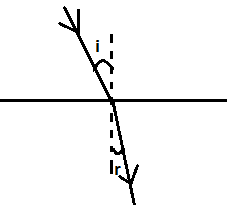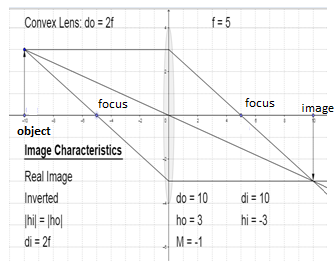
The image distance of an object placed \[10cm\] in front of a thin lens of focal length \[+5cm\]
Answer
514.2k+ views
Hint: The relation between object distance, image distance and focal length is given by the lens formula. Substituting corresponding values in the lens formula and putting the correct sign for each by following the sign convention will give us the required value of image distance.
Formulas Used:
\[\dfrac{1}{v}-\dfrac{1}{u}=\dfrac{1}{f}\]
Complete answer:
Refraction is the bending of rays of light when it passes from one medium to the other. When light passes through a lens, it undergoes refraction.

Given- focal length is \[+5cm\]. This means that it is a convex lens as convex lenses have positive focal lengths.
By convention all distances in front of the lens are taken as positive and distances behind the lens are taken as negative. Therefore, image distance in a convex lens is positive but object distance is negative.
The Lens formula is given by-
\[\dfrac{1}{v}-\dfrac{1}{u}=\dfrac{1}{f}\] - (1)
Here, \[v\] is the image distance from the centre of lens
\[u\] is the object distance from center of lens
\[f\] is focal length of the lens
Substituting the given values in eq (1), we have,
\[\begin{align}
& \dfrac{1}{v}-\dfrac{1}{-10}=\dfrac{1}{5} \\
& \dfrac{1}{v}=\dfrac{1}{5}-\dfrac{1}{10} \\
& \Rightarrow \dfrac{1}{v}=\dfrac{1}{10} \\
\end{align}\]
\[\therefore v=10cm\] - (2)
The image distance is \[10cm\] in front of the lens, this is equal to object distance behind the lens. The image is formed at \[2f\], it is real, inverted and the same size as the object

Here,
\[{{d}_{o}}\] is the object distance
\[{{d}_{i}}\] is the image distance
\[{{h}_{o}}\] is the object height
\[{{h}_{i}}\] is the image height
\[M\] is the magnification, that is, ratio of image height to object height
Note:
There are different image formations in a convex lens. It forms a virtual image if the object distance is \[u2f\] the image formed is diminished, real and inverted and formed beyond \[2f\].
Formulas Used:
\[\dfrac{1}{v}-\dfrac{1}{u}=\dfrac{1}{f}\]
Complete answer:
Refraction is the bending of rays of light when it passes from one medium to the other. When light passes through a lens, it undergoes refraction.

Given- focal length is \[+5cm\]. This means that it is a convex lens as convex lenses have positive focal lengths.
By convention all distances in front of the lens are taken as positive and distances behind the lens are taken as negative. Therefore, image distance in a convex lens is positive but object distance is negative.
The Lens formula is given by-
\[\dfrac{1}{v}-\dfrac{1}{u}=\dfrac{1}{f}\] - (1)
Here, \[v\] is the image distance from the centre of lens
\[u\] is the object distance from center of lens
\[f\] is focal length of the lens
Substituting the given values in eq (1), we have,
\[\begin{align}
& \dfrac{1}{v}-\dfrac{1}{-10}=\dfrac{1}{5} \\
& \dfrac{1}{v}=\dfrac{1}{5}-\dfrac{1}{10} \\
& \Rightarrow \dfrac{1}{v}=\dfrac{1}{10} \\
\end{align}\]
\[\therefore v=10cm\] - (2)
The image distance is \[10cm\] in front of the lens, this is equal to object distance behind the lens. The image is formed at \[2f\], it is real, inverted and the same size as the object

Here,
\[{{d}_{o}}\] is the object distance
\[{{d}_{i}}\] is the image distance
\[{{h}_{o}}\] is the object height
\[{{h}_{i}}\] is the image height
\[M\] is the magnification, that is, ratio of image height to object height
Note:
There are different image formations in a convex lens. It forms a virtual image if the object distance is \[u
Recently Updated Pages
Transformation Matrix Explained: 4x4 Types & Uses (2025 Guide)

Unit Matrix Explained: Definition, 3x3 & 2x2 Examples for 2025

Sum of Cubes Formula: Find the Sum of Cubes of n Natural Numbers

Surjective Function Explained for Students (2025)

Multiplying and Dividing Exponents: Rules & Step-by-Step Guide (2025)

Factored Form Explained: How to Convert & Examples for 2025

Trending doubts
When was the first election held in India a 194748 class 12 sst CBSE

Which are the Top 10 Largest Countries of the World?

Differentiate between homogeneous and heterogeneous class 12 chemistry CBSE

Why is the cell called the structural and functional class 12 biology CBSE

a Tabulate the differences in the characteristics of class 12 chemistry CBSE

The first general election of Lok Sabha was held in class 12 social science CBSE




